springboot自定义starter springboot自定义starter实现过程图解
西西嘛呦 人气:0这篇文章主要介绍了springboot自定义starter实现过程图解,文中通过示例代码介绍的非常详细,对大家的学习或者工作具有一定的参考学习价值,需要的朋友可以参考下
1、创建一个Empty Project
2、在该工程中点击+,选择new module,新建一个maven工程
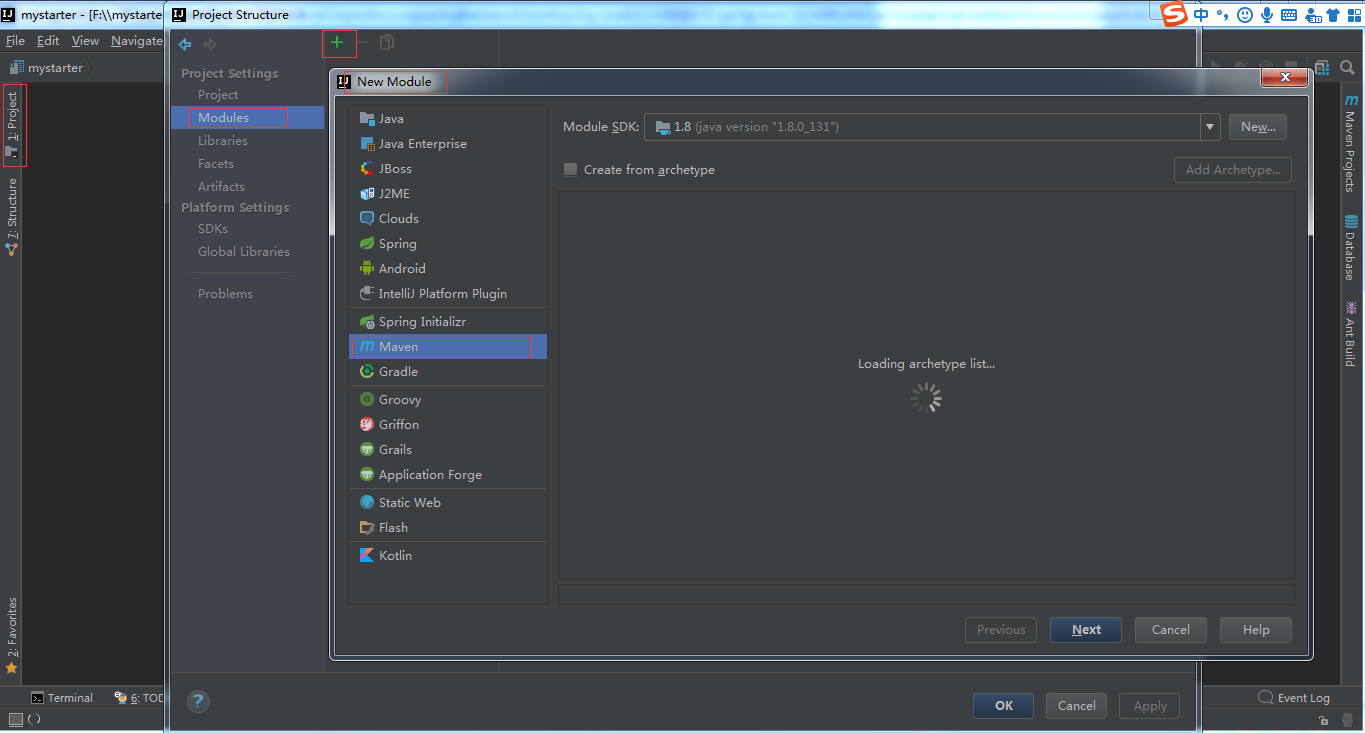
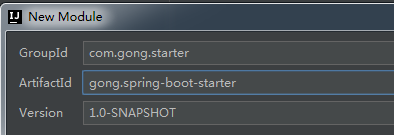

点击确定。
3、在该工程中点击+,选择new module,新建一个Spring Initializr工程
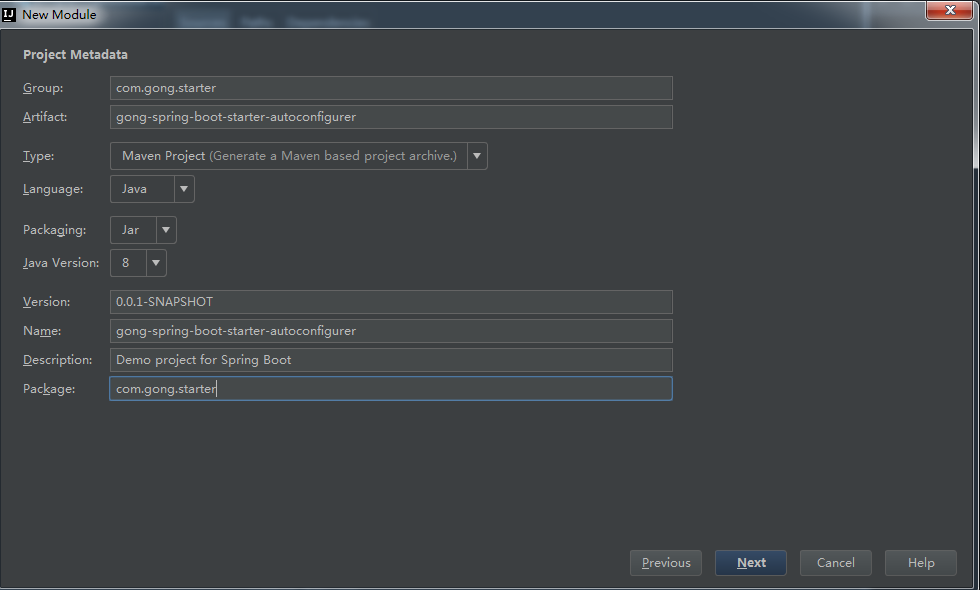
后面直接默认next,然后点击finishi。
两个都创建完毕之后点击apply,点击OK。得到如下结构:
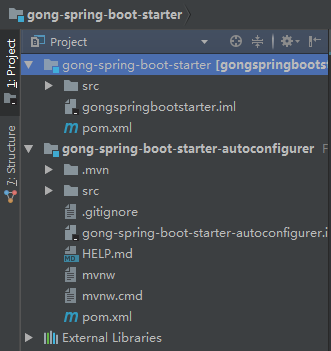
4、在gong-spring-boot-starter中引入gong-spring-boot-starter-autoconfigurer,即在gong-spring-boot-starter的pom.xml中
<?xml version="1.0" encoding="UTF-8"?>
<project xmlns="http://maven.apache.org/POM/4.0.0"
xmlns:xsi="http://www.w3.org/2001/XMLSchema-instance"
xsi:schemaLocation="http://maven.apache.org/POM/4.0.0 http://maven.apache.org/xsd/maven-4.0.0.xsd">
<modelVersion>4.0.0</modelVersion>
<groupId>com.gong.starter</groupId>
<artifactId>gong.spring-boot-starter</artifactId>
<version>1.0-SNAPSHOT</version>
<dependencies>
<!--引入自动配置模块-->
<dependency>
<groupId>com.gong.starter</groupId>
<artifactId>gong-spring-boot-starter-autoconfigurer</artifactId>
<version>0.0.1-SNAPSHOT</version>
</dependency>
</dependencies>
</project>
我们看下gong-spring-boot-starter-autoconfigurer中的pom.xml
<?xml version="1.0" encoding="UTF-8"?>
<project xmlns="http://maven.apache.org/POM/4.0.0" xmlns:xsi="http://www.w3.org/2001/XMLSchema-instance"
xsi:schemaLocation="http://maven.apache.org/POM/4.0.0 https://maven.apache.org/xsd/maven-4.0.0.xsd">
<modelVersion>4.0.0</modelVersion>
<parent>
<groupId>org.springframework.boot</groupId>
<artifactId>spring-boot-starter-parent</artifactId>
<version>2.2.4.RELEASE</version>
<relativePath/> <!-- lookup parent from repository -->
</parent>
<groupId>com.gong.starter</groupId>
<artifactId>gong-spring-boot-starter-autoconfigurer</artifactId>
<version>0.0.1-SNAPSHOT</version>
<name>gong-spring-boot-starter-autoconfigurer</name>
<description>Demo project for Spring Boot</description>
<properties>
<java.version>1.8</java.version>
</properties>
<dependencies>
<!--引入spring-boot-starter:所有starter基本配置-->
<dependency>
<groupId>org.springframework.boot</groupId>
<artifactId>spring-boot-starter</artifactId>
</dependency>
</dependencies>
</project>
删除掉创建项目时自动配置的其它东西,只需要一个标红的依赖即可。
5、在gong-spring-boot-starter-autoconfigurer就可以编写场景启动的相关逻辑啦。
(1)新建如下目录结构及文件
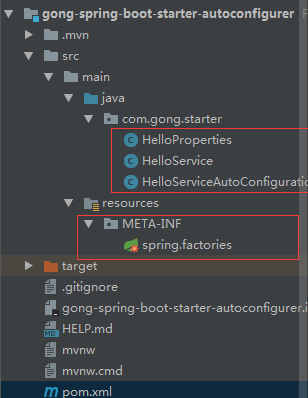
springboot启动入口可以删去,resources下文件删去,test文件夹删去。在com.gong.starter下新建以上三个java文件,在resources下新建META-INF文件夹,再新建spring.factories文件。
HelloService.java
package com.gong.starter;
public class HelloService {
HelloProperties helloProperties;
public HelloProperties getHelloProperties() {
return helloProperties;
}
public void setHelloProperties(HelloProperties helloProperties) {
this.helloProperties = helloProperties;
}
public String sayHelloGong(String name){
return helloProperties.getPrefix()+"-" +name + helloProperties.getSuffix();
}
}
sayHelloGong方法可以获取HelloProperties中的属性,包括前缀和后缀,然后返回:前缀-name后缀。
HelloProperties.java
package com.gong.starter;
import org.springframework.boot.context.properties.ConfigurationProperties;
//绑定所有以gong.hello开头的配置
@ConfigurationProperties(prefix = "gong.hello")
public class HelloProperties {
private String prefix;
private String suffix;
public String getPrefix() {
return prefix;
}
public void setPrefix(String prefix) {
this.prefix = prefix;
}
public String getSuffix() {
return suffix;
}
public void setSuffix(String suffix) {
this.suffix = suffix;
}
}
绑定配置以及定义属性。
HelloServiceAutoConfiguration.java
package com.gong.starter;
import org.springframework.beans.factory.annotation.Autowired;
import org.springframework.boot.autoconfigure.condition.ConditionalOnWebApplication;
import org.springframework.boot.context.properties.EnableConfigurationProperties;
import org.springframework.context.annotation.Bean;
import org.springframework.context.annotation.Configuration;
@Configuration //是一个配置类
@ConditionalOnWebApplication //web应用才生效
@EnableConfigurationProperties(HelloProperties.class) //让属性文件生效
public class HelloServiceAutoConfiguration {
@Autowired
HelloProperties helloProperties;
@Bean
public HelloService helloService(){
HelloService service = new HelloService();
service.setHelloProperties(helloProperties);
return service;
}
}
自动配置类。要加入三个注解,并对方法使用@Bean标注。
最后,就是在spring.factories中进行配置自动注册:
org.springframework.boot.autoconfigure.EnableAutoConfiguration=\
com.gong.starter.HelloServiceAutoConfiguration
这样,我们自己定义的场景启动器就完成了。
接下来新建一个springboot项目进行测试,首先在pom.xml中导入自己定义的场景启动器:
<!--引入自定义的starter-->
<dependency>
<groupId>com.gong.starter</groupId>
<artifactId>gong.spring-boot-starter</artifactId>
<version>1.0-SNAPSHOT</version>
</dependency>
然后编写application.properties定义场景启动器的属性:
gong.hello.prefix=GONG gong.hello.suffix=HELLO WORLD
接着编写一个测试类:
package com.gong.springbootjpa.controller;
import com.gong.starter.HelloService;
import org.springframework.beans.factory.annotation.Autowired;
import org.springframework.web.bind.annotation.GetMapping;
import org.springframework.web.bind.annotation.RestController;
@RestController
public class HelloController {
@Autowired
HelloService helloService;
@GetMapping("/hello")
public String hello(){
return helloService.sayHelloGong("haha");
}
}
启动服务器:

完美。
您可能感兴趣的文章:
- 手撸一个 spring-boot-starter的全过程
- 聊一聊带智能提示的spring-boot-starter
- 使用SpringBoot自定义starter的完整步骤
- SpringBoot自动配置之自定义starter的实现代码
- springboot自定义redis-starter的实现
- SpringBoot2.1.x,创建自己的spring-boot-starter自动配置模块操作
- SpringBoot如何实现starter原理详解
- SpringBoot启动器Starters使用及原理解析
- Spring Boot企业常用的starter示例详解
- Spring boot创建自定义starter的完整步骤
- 如何手写一个Spring Boot Starter
加载全部内容